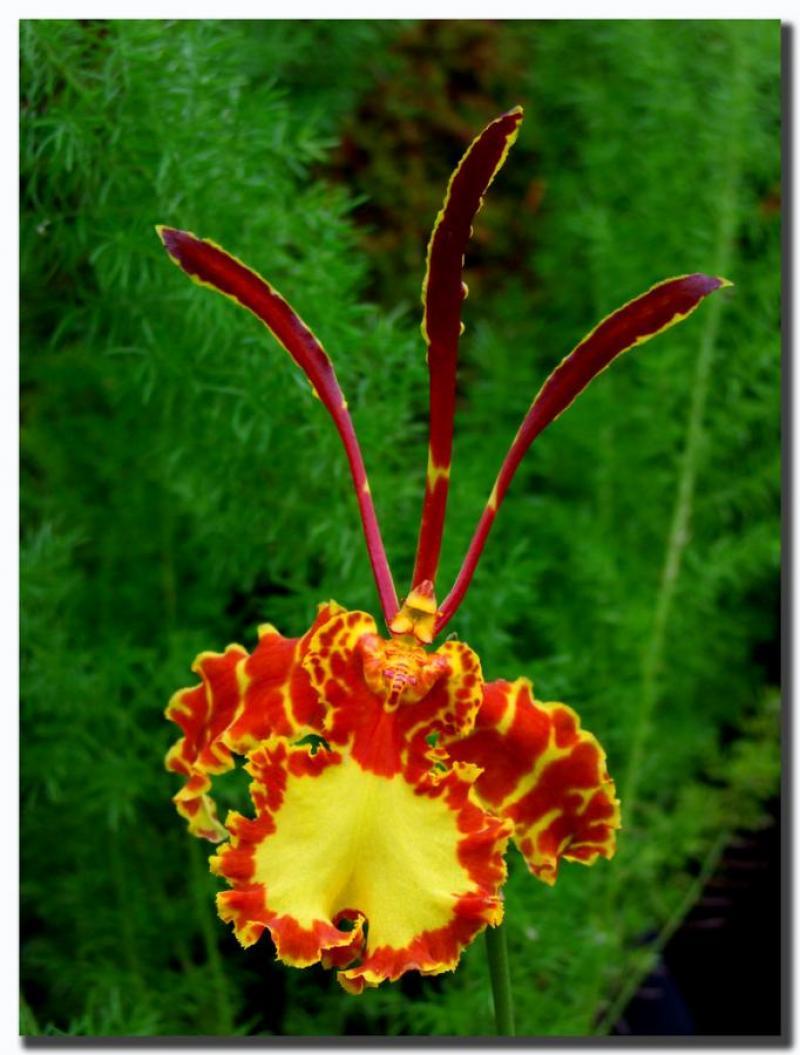Psychopsis papilio
Also known as: The Butterfly Psychopsis or Psychopsis latourae Psychopsis papilio f. latourae Oncidium papilio h.v. krameri Psychopsis papilio h.f. xanthina Oncidium papilio h.v. pictum Oncidium papilio h.f. album Oncidium papilio h.v. echkardti Oncidium papilio h.f. alba Psychopsis papilio var. albiflora Psychopsis papilio h.f. alba Psychopsis papilio h.f. aurea Oncidium papilio h.v. majus Psychopsis papilio var. latourae Psychopsis papilio h.v. atlas Psychopsis picta Psychopsis papilio h.v. latourea Oncidium papilio var. albiflorum Oncidium papilio var. latourae Oncidium papilio f. latourae Oncidium papilio var. limbatum in the subfamily: Epidendroideae
Native to: Departamento del Huila - Colombia
General Information
The Butterfly Psychopsis is a medium sized sympodial warm to hot growing epiphytic orchid belonging to the sub family Epidendroideae native to Colombia.
Plant Description
Sympodial. Grows to 19-28cm. Each new growth has numerous leaves that grow to 15-23cm long. Pseudobulbs grow to 3.7-5cm
Flowers
Numerous long lasting blossoms appear
Substrate(s)
- Coarse
- Charcoal
- Treefern
- Spaghnum Moss
- Perlite
Care Notes
These orchids like to be kept on the dry side, but may need to be watered daily during warm weather, and prefer a well draining mix or also do well mounted, provided they can be watered regularly.
These are quite a forgiving orchid, there are no special requirements to get this orchid to flower, just good care and consistent conditions. Larger plants may be more fussy and can react poorly to change; a poorly timed repotting, a pest infection or an unusually hot day can set them back for a couple of years. However, even plants that have been treated poorly can thrive, and if they are set back they often recover much stronger then they would otherwise be.
Climate
Grows at low to high elevations. Rainfall ranges from 0mm to 201mm per day, heaviest in August and lightest in March. Humidity ranges from 62% to 81%, highest in August and lowest in March. Temperature ranges from 14C to 29C, highest in March (18C to 29C) and lowest in January (14C to 27C).
Watering
These orchids are sensitive to excessive watering and should only be watered when they look thirsty. Water infrequently and ensure that the roots are dry before watering. Keep an eye on them especially during hot weather as overwatering can lead to rot, whereas underwatering may result in wilting or shriveling, which while unattractive, will not kill the plant.
Keep moisture levels up during hot weather as the plant is prone to dehydrationFertiliser
These orchids do not need to be regularly fertilised and roots may be sensitive to salt build-up, dying back and therefore impairing the plants growth or even killing it.
If fertilising, use half to quarter of the recommended amount of fertiliser. If they receive fertiliser as part of a collection, be sure to flush out the pots regularly with fresh water and monitor the roots by checking how much resistance is given by the plant when nudged in its pot or mount. If the plant becomes wobbly or loose, repot in fresh mix or rinse the media/mount thoroughly and do not fertilise for at least 3 months.
Use balanced fertiliser year round. Apply fertiliser regularly at half strength year round. This plant is sensitive so apply fertiliser sparingly at one quarter recommended strength or less. Use a low Nitrogen fertiliser during Winter. Use a high Phosphorous fertiliser during Winter.Potting
These plants are quite forgiving and will do well repotted ever 2-3 years. The mix should be coarse, well draining, and allow space for air to move and for roots to grow.
Alternatively, these plants will also do well mounted to tree fern or cork slabs, or mounted to trees.
Best time for repotting or mounting the orchids is the end of winter when new growths start to appear. Avoid repotting during hot weather,
Use water retentive media such as moss to prevent roots from drying out quickly This plant does very well in baskets or suspended pots This plant does well mounted to Cork slabs. Repotting is best done annually and in a pot the same size or only slightly larger than the previous one.




















